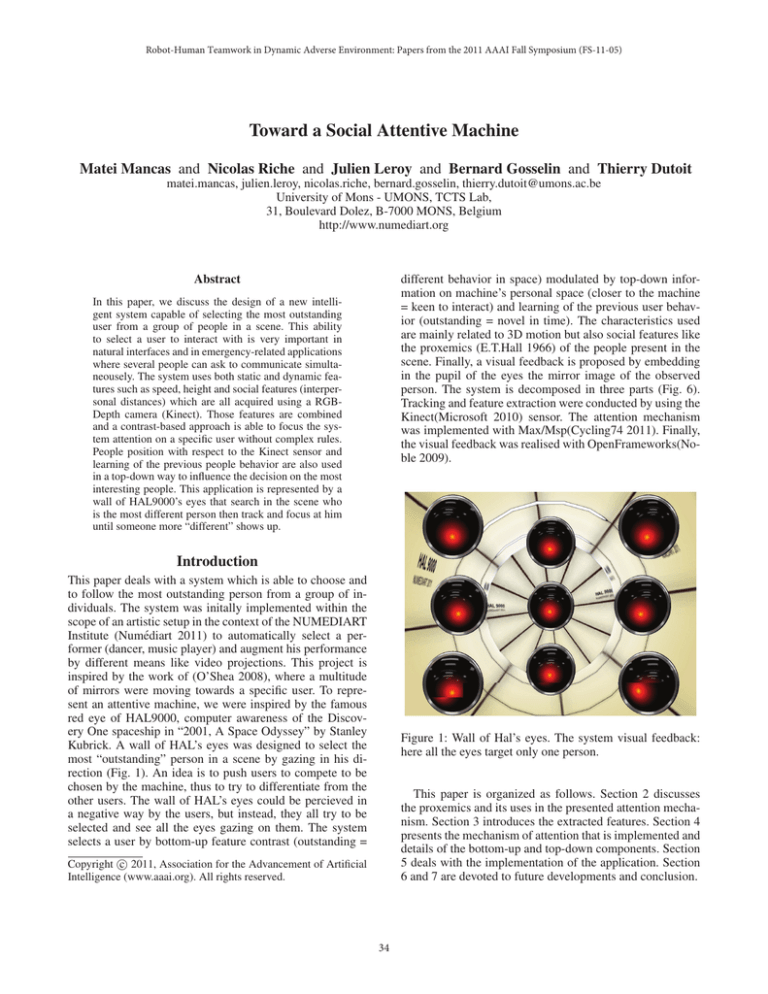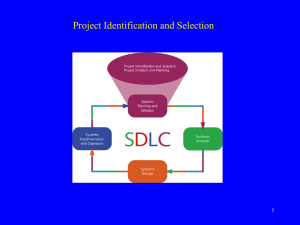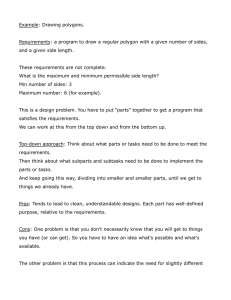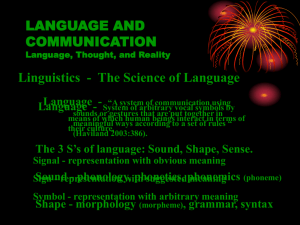
Robot-Human Teamwork in Dynamic Adverse Environment: Papers from the 2011 AAAI Fall Symposium (FS-11-05)
Toward a Social Attentive Machine
Matei Mancas and Nicolas Riche and Julien Leroy and Bernard Gosselin and Thierry Dutoit
matei.mancas, julien.leroy, nicolas.riche, bernard.gosselin, thierry.dutoit@umons.ac.be
University of Mons - UMONS, TCTS Lab,
31, Boulevard Dolez, B-7000 MONS, Belgium
http://www.numediart.org
different behavior in space) modulated by top-down information on machine’s personal space (closer to the machine
= keen to interact) and learning of the previous user behavior (outstanding = novel in time). The characteristics used
are mainly related to 3D motion but also social features like
the proxemics (E.T.Hall 1966) of the people present in the
scene. Finally, a visual feedback is proposed by embedding
in the pupil of the eyes the mirror image of the observed
person. The system is decomposed in three parts (Fig. 6).
Tracking and feature extraction were conducted by using the
Kinect(Microsoft 2010) sensor. The attention mechanism
was implemented with Max/Msp(Cycling74 2011). Finally,
the visual feedback was realised with OpenFrameworks(Noble 2009).
Abstract
In this paper, we discuss the design of a new intelligent system capable of selecting the most outstanding
user from a group of people in a scene. This ability
to select a user to interact with is very important in
natural interfaces and in emergency-related applications
where several people can ask to communicate simultaneousely. The system uses both static and dynamic features such as speed, height and social features (interpersonal distances) which are all acquired using a RGBDepth camera (Kinect). Those features are combined
and a contrast-based approach is able to focus the system attention on a specific user without complex rules.
People position with respect to the Kinect sensor and
learning of the previous people behavior are also used
in a top-down way to influence the decision on the most
interesting people. This application is represented by a
wall of HAL9000’s eyes that search in the scene who
is the most different person then track and focus at him
until someone more “different” shows up.
Introduction
This paper deals with a system which is able to choose and
to follow the most outstanding person from a group of individuals. The system was initally implemented within the
scope of an artistic setup in the context of the NUMEDIART
Institute (Numédiart 2011) to automatically select a performer (dancer, music player) and augment his performance
by different means like video projections. This project is
inspired by the work of (O’Shea 2008), where a multitude
of mirrors were moving towards a specific user. To represent an attentive machine, we were inspired by the famous
red eye of HAL9000, computer awareness of the Discovery One spaceship in “2001, A Space Odyssey” by Stanley
Kubrick. A wall of HAL’s eyes was designed to select the
most “outstanding” person in a scene by gazing in his direction (Fig. 1). An idea is to push users to compete to be
chosen by the machine, thus to try to differentiate from the
other users. The wall of HAL’s eyes could be percieved in
a negative way by the users, but instead, they all try to be
selected and see all the eyes gazing on them. The system
selects a user by bottom-up feature contrast (outstanding =
Figure 1: Wall of Hal’s eyes. The system visual feedback:
here all the eyes target only one person.
This paper is organized as follows. Section 2 discusses
the proxemics and its uses in the presented attention mechanism. Section 3 introduces the extracted features. Section 4
presents the mechanism of attention that is implemented and
details of the bottom-up and top-down components. Section
5 deals with the implementation of the application. Section
6 and 7 are devoted to future developments and conclusion.
c 2011, Association for the Advancement of Artificial
Copyright Intelligence (www.aaai.org). All rights reserved.
34
Proxemics: a Social Feature for a Social
Attentive Machine
level information compared to personal low level features
(position alone, speed, direction) by introducing special relativity between people.
People create unconscious territories around them, which
define and determine the interactions they can have with
other people. Those territories are like invisible bubbles surrounding and keeping them far from each other, unless space
has some physical constraints (small room, crowded environment...). E.T.Hall, in his studies about the human behaviour in public space (E.T.Hall 1966), introduced for the
first time this concept of interpersonal distances or proxemics. He also proposed the most widespread model of interpersonal spaces: it divides the space around a person in
four distinct regions as shown in Fig. 2:
Features Extraction
The first step for an interactive machine is to extract features from the observed people. For that purpose, we use the
Kinect sensor for its ability to extract smooth depth maps in
complex illumination conditions. Also libraries as OpenNI
(OpenNI 2011) are available to detect human silhouettes and
extract anatomical features from skeletons tracking (Fig. 3).
1. Intimate distance (0 to 45 cm): a really close space with
high probability of physical contact. It is a distance for
touching, whispering or embracing someone. It indicates
a close relationship (lovers, children, ...)
2. Personal distance (45cm to 1.2m): distance for interacting
with family members or good friends. The other person is
at arm’s length, only ritualized touch (handshake, ...) can
happen.
3. Social distance (1.2m to 3.5m): distance for more formal
or impersonal interactions. It’s the distance people naturally hold when they meet unknown people and establish
a communication process with them.
4. Public distance (3.5 to infinity): distance for mass meeting, lecture hall or interactions with important personalities.
Figure 3: Real-time multi-users tracking, automatic skeleton
fitting and personal space modelisation: red = intimate, blue
= personal space.
Automatic skeleton fitting
A first issue which has to be solved for an interactive system is the skeleton calibration. The OpenNI library requires
people to stay in a specific position (psy-like pose) in order
to get a skeleton, which is not very convenient especially
when there are several users in public places. Nevertheless,
this issue can be solved by saving the parameters of one person (who has to calibrate) and then fit automatically those
parameters to any new user. In our case, this solution works
well because we mainly use the position of the head and upper body parts.
Figure 2: Definition of Hall’s personal spaces model. Four
areas divide the spaces around people: the intimate space,
the personal space, the social space and the public space.
Behavioural Features
Social Signals In a previous work (Leroy, Mancas, and
Gosselin 2011), we developed tools to study proxemics
on ecological scenes. Our objective was to propose a new
methodology to study spatial behaviours in natural scenes
using 3D cameras. The system can, precisely and in real
time, detect users, measure interpersonal distances and displays a virtual view of the personal spaces model proposed
by E.T.Hall (Fig. 4). This social spatial information is used
here to detect who has the most outstanding spatial behaviour. For this purpose, we compute the mean distance
between each person on the scene, based on the position of
their 3D centroid. The one with the contrasted mean distance, in terms of euclidian distances, will draw the attention. We also use another social information which is people’s height. Height can give us precious information on the
In a way, the measure of these distances is a clue that can
tell us how people know each other, we can make the assumption that they are probably part of a group, that they
are lovers, etc. People update, control, and adjust their personal spaces continuously: any unauthorised penetration of
these spaces will cause a feeling of discomfort. This can lead
to an aggressive response of the subject who may feel oppressed by the presence of the intruder. Interpersonal spaces
are complex social mechanisms and depend on many parameters: they continuously evolve and adapt to the context.
They should be seen as dynamic and elastic territories varying with lot of parameters like: culture, sex, age, gender,
size, social position, relationship or physical appearance.
Observing the spatial behaviour of people provides higher
35
nature and behaviour of the person present in the scene. We
look at who has the most outstanding height to weight the
saliency map. A child in a group of adults will draw the
attention and the reverse is also true. The scenario, where
someone crouches while the others stand up, follows the
same rules. It is also an interesting information correlated
to the proxemics behaviour and first results, observed with
(Leroy, Mancas, and Gosselin 2011), seem to show that the
evolution of the size of our personal space can be linked to
the size of the people interacting.
make the move towards more realistic ambient intelligence
systems.
Bottom-up Contrast-Based Attention Mechanism
As stated in (Mancas 2007) and (Mancas et al. 2007) a feature does not attract attention by itself: bright and dark, locally contrasted areas or not, red or blue can equally attract
human attention depending on their context. In the same
way, motion can be as interesting as the lack of motion
depending on the context. The main cue, which involves
bottom-up attention, is the contrast and rarity of a feature
in a given context. We based our approach on (Mancas et al.
2010). In our case, as the group of people is small, the rarity
computation is not relevant, therefore we only use the global
contrast. Thus, the first step in this section is to calculate for
each feature i ( fi,k ) a contrast betwen the different users k
(Ci,k ):
|f −f |
(1)
Ci,k = ∑Nj=1 i,kN−1i, j
where N is the number of users. Once all the contrasts for
a given feature Ci,k between each user and the others have
been computed, they are ordered in ascending order Ci,k,o
with o = [1 : N] from the maximum (o = 1) to the minimum
(o = N). The difference between the two highest values is
compared to a threshold T which decides if the contrast is
large enough to be taken into account as in Eq. 2.
α = 0 i f Ci,k,1 −Ci,k,2 < T
(2)
α > 0 i f Ci,k,1 −Ci,k,2 ≥ T
Figure 4: Personal Space Augmented Reality Tool (Leroy,
Mancas, and Gosselin 2011). Software developed to study
proxemics behavior in ecological scene using the Kinect.
Motion Features In addition to the static social features
previously described, we also observed 3D motion (speed
on the 3 axes). The Kinect sensor makes it easy to detect the
position of different users. Based on the estimation of their
respective centroid, it is possible to study their movement in
a 3D space. The motion speed will be the dynamic feature
for the bottom-up part of the process of attention. The slower
or faster person, in contrast to the rest of the group, will get
a higher saliency.
Only the features being the largest and passing this threshold T are merged with different weights (Eq. 3).
Ck = ∑H
i=1
Ci,k ∗Wi ∗α
H
(3)
Where H is the number of features and α is given in Eq.
2. The way the values of the weights Wi is set is described
in the next section. This contrast Ck represents the bottomup saliency for each user k. Saliency will be higher for the
people exhibiting the most contrasted features (motion, position) within a given frame. For each frame it is possible
to highlight the most different behavior: if we take into account the proxemics-related features for example, a person
who is isolated compared to the others will attract the system
attention. An interesting fact concering proxemics is that if
several people are aligned, it is the individual at the center
that will attract the attention which is finally what humans
would naturally do (if they would take into account only the
interpersonal distances). Also, a person staying still can be
salient if all the others move which shows that in our approach motion is not necessary salient by itself (of course
most of the time, motion is also rare and salient but in some
confiurations where static objects are more rare than moving
ones, the lack of motion can be surprising).
Who’s Different? Use of Computational
Attention
The aim of computational attention is to provide algorithms
to automatically predict human attention. The term of attention refers to the whole attentional process that allows one to
focus on some stimuli at the expense of others. Human attention is mainly divided into two main influences: a bottom-up
and a top-down one. Bottom-up attention uses signal characteristics to find the most salient or outstanding objects. Topdown attention uses a priori knowledge about the scene or
task-oriented knowledge in order to modify (inhibit or enhance) the bottom-up saliency. The relationship and the relative importance between bottom-up and top-down attention
is complex and it can vary depending on the situations (Mancas 2009). Much research has already addressed the computational visual attention, but these works were devoted almost exclusively to 2D image analysis: up to now little has
been done on 3D data (Riche et al. 2011). The arrival on
the market of low cost 3D cameras opens up new prospects
for developing algorithms for visual attention, which should
Top-down Information for Adaptative Features
Weights
The weights Wi from Eq. 3 can be adapted via the top-down
component of attention. Those weights are initially set to be
the same for all the 4 features which are used here. Than, the
36
number of times a feature is contrasted enough for a given
user (al pha > 0), a counter is increased. The feature weights
will be inversely proportional to their counters: if a feature
i is often contrasted, its weight will be lower and lower,
while a feature which is rarely contrasted enough will see its
weight increased. This mechanisms ensures a higher weight
to novel behavior while too repetitive behavior will be penalized. As an example, someone who first will sit down
(different height feature compared to the others), the height
will have the maximum weight. If this person thinks that
a different height is enough to attract the system attention,
he will try again, but the more he tries again, the more the
height feature weight will decrease as this behavior is no
longer surprising. This top-down approach allows the system to learn how much a feature is novel and provide higher
weights to the most novel ones. While the bottom-up approach will analyse in each frame which person behaves in
a different way compared to the others, the top-down apporach will also look for people who behave in a novel (or less
repetitive) way from the beginning of the observation.
Figure 5: Left, selected user with the bottom-up component;
the isolated one is chosen. Right, with the top-down component, we select the closer to the system as his weight is
doubled.
Adding Top-Down Social Information
The weights Wi from Eq. 3 can also be changed via another top-down component. For this purpose, we used the
concept of proxemics applied to the system itself. This concept is not only restrained to human-to-human interaction
but it can be also applied for human-computer interaction.
Some research have already been done on the spatial interaction we can have with computers (Ballendat, Marquardt, and
Greenberg 2010) or with virtual worlds (Friedman, Steed,
and Slater 2007) and it seems that we often behave in the
same way with machines than with humans. Thus, the proposed system was given its own proxemics behaviour. We
defined two social territories around our installation, physically represented by the center of the screen (Fig. 5). The
contrast equation with the top-down component becomes:
Ck = ∑H
i=1
Ci,k ∗Wi ∗α∗β
H
Figure 6: Workflow of HAL’s project. First, features acquisition with the the Kinect and OpenNI middleware. Second,
attention mechanism implemented on Max/Msp. Third, user
feedback displayed with OpenFramworks.
the scene, the OpenNI framework was used, that supports
the Kinect camera and allows the design of natural user interfaces. This library is used to realise people detection, segmentation and head-tracking. Detection is for orienting the
gazes and provides features to the attention mechanism. Segmentation and head-tracking are part of the visual feedback
given back to the users to encourage them to compete to
be selected by the machine. First, the tracked person is segmented, then we superimpose the mirror image of the followed person in the pupil of the eyes. Secondly, with the
head-tracking possibility, we change dynamically the field
of view of the application to create a impression of 3D and
the continuity of the real world into the virtual world, Fig. 7.
Finally, the implementation of our attention mechanism and
the features’ processing was performed using Max / Msp,
a platform for real-time signal processing which allows fast
prototyping by using visual programing with libraries supported by a large community. To communicate the skeleton
information obtained with OpenNI, we developed a small
application that sends joints and user information to Max
using OSC (OpenSoundControl (OSC 2011)) protocol.
(4)
Where β = 2 if the user is located closer to the system and
β = 1 if he is located in the farther space. Fig. 5 shows differences between bottom-up attention alone and top-down
modulation adding proxemics information.
Implementation and User Feedback
To achieve our application, different modules were used
(Fig. 6). Firstly, the graphic look was achieved using OpenFrameworks, a C++ library dedicated to creative coding,
bringing together diverse libraries like OpenGL, OpenCV,
etc. The first step to create this watching machine was to
calibrate the gazes from the eyes on the real world. Like the
wall of eyes is not plane but a piece of cylinder, Fig. 7, we
design a 3D virtual world, where are drawn the eyes, like an
extension of the real world. In that way, we wanted to give
the impression that the screen is the frontier between the two
worlds. This setup makes it easy to calibrate the installation
at the size of the screen and lets the gazes look precisely into
the real world since everything is computed on the basis of a
single mark that is the Kinect camera. Secondly, to analyse
A Kinect-Based Network
An issue of the Kinect is the limited interaction space which
is very convenient for single user but too limited for more
than 4 users. The solution we used to overcome this issue
was to calibrate together several Kinects and to fuse the data
coming from the two cameras. The implemented solution
uses two Kinects but it could be easily generalized to several
37
Figure 7: Left, wall of Hal’eyes represented like an extension of the real world. Right, visual feedback given to the
selected user: mirroring effect and 3D impression done with
headtracking.
sensors. The number of cameras is limited by the number of
USB busses installed on the computer. To solve this first issue, and to augment the number of sensors, we developed
an application that works with a master-slave architecture
(Fig. 9). The slave instances of the tool realise the capture
and tracking then send the users’ position and skeletons to
the master with OSC messages. Each slave is provided with
a transformation matrix giving its position in the coordinates
system of the master. This transformation matrix is obtained
by doing a registration step on the overlapping point clouds
given by the slave and by the master. To do this, we use
spatial filtering to limit the point clouds of each view at the
overlapping area then an initial guess of the cameras position is obtain by a manual registration. Finally, we refine
the calibration by using the automatic ICP algorithm (Zhang
1994). As we have the position of each cameras, we can fuse
all users’ data and get a large interactive scene. Our results
are promising. The accuracy of close objects (50 centimeters
to 4 meters) is good, while this accuracy is lower and lower
when getting far from the sensor due to registration errors.
Fig. 8 shows the 3D point cloud coming from two different
Kinects after registration.
When the user is swithing from a Kinect to the second
one (exterior screans on Fig. 9), his skeleton keeps a precise
colour (blue or pink) but it is still there.
Figure 8: Registration of point clouds provided by 2 different
Kinects. Unregistered cloud points ont top, registered clouds
on bottom.
Figure 9: From left to right: left slave instance (left kinect),
the master instance, right slave instance (right kinect) .
work will focus, first, to enrich the model of attention with
a higher number of features. Tracking on a wider scene provides access to more people, opportunities and social behaviours. It will be interesting to study the dynamics of these
different social groups, their creation, their division, their interaction in the same way as we analysed individuals more
”isolated”.
Conclusion and Perspectives
In this paper, we propose an attention-based people selection
system which uses 3D motion features. Moreover, we introduce higher level characteristics based on social behaviour.
The proxemics, used in bottom-up and top-down analysis,
provides context information on the interaction people could
have on the scene. We used this algorithm to make our interactive art installation which aims in augmenting artists
performances. Another application is a system which could
communicate with one person chosen between several others keen to communicate in parallel which occurs in emergency situations. The system can also be used to study people reaction and interaction in a competing scenario. More
generally, a system which is able to choose among several
people the one with who it wants to interact in a natural
way has plenty of applications for intelligence HCI. Future
Acknowledgements
This work was funded by the Numediart Institute
(www.numediart.org), Walloon region, Belgium.
References
Ballendat, T.; Marquardt, N.; and Greenberg, S. 2010. Proxemic interaction: Designing for a proximity and orientationaware environment. ITS ’10 ACM International Conference
on Interactive Tabletops and Surfaces.
Cycling74. 2011. Max/msp, http://cycling74.com.
E.T.Hall. 1966. The Hidden Dimension. Anchor Books.
38
Friedman, D.; Steed, A.; and Slater, M. 2007. Spatial social behavior in second life. IVA ’07 Proceedings of the 7th
international conference on Intelligent Virtual Agents.
Leroy, J.; Mancas, M.; and Gosselin, B. 2011. Personal
space augmented reality tool. First joint WIC/IEEE SP Symposium on Information Theory and Signal Processing in the
Benelux.
Mancas, M.; Mancas-Thillou, C.; Gosselin, B.; and Macq,
B. 2007. A rarity-based visual attention map–application
to texture description. Proceedings of IEEE International
Conference on Image Processing.
Mancas, M.; Glowinski, D.; Volpe, G.; Coletta, P.; and Camurri, A. 2010. Gesture saliency: a context-aware analysis. Gesture in Embodied Communication and HumanComputer Interaction.
Mancas, M. 2007. Computational attention: Towards attentive computers. CIACO University Distributors.
Mancas, M. 2009. Relative influence of bottom-up and
top-down attention. Attention in Cognitive Systems, Lecture
Notes in Computer Science.
Microsoft.
2010.
Microsoft’s kinect,
http://www.xbox.com/kinect.
Noble, J.
2009.
Programming Interactivity: A Designer’s Guide to Processing, Arduino, and Openframeworks. O’Reilly.
Numédiart.
2011.
Numédiart institute,
http://www.numediart.org/.
OpenNI. 2011. Openni, http://www.openni.org/.
OSC.
2011.
Open
sound
control,
http://opensoundcontrol.org/.
O’Shea,
C.
2008.
Audience,
http://www.chrisoshea.org/audience.
Riche, N.; Mancas, M.; Gosselin, B.; and Dutoit, T. 2011. 3d
saliency for abnormal motion selection: the role of the depth
map. ICVS2011 8th International Conference on Computer
Vision Systems.
Zhang, Z. 1994. Iterative point matching for registration
of free-form curves and surfaces. International Journal of
Computer Vision.
39







